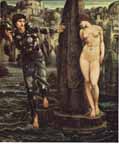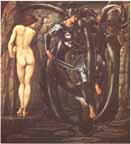

After meeting in 1853 at Exeter College at Oxford, William Morris and Edward Burne-Jones both abandoned their weak intentions to become clergymen to pursue their greater passions of art. Morris wrote poetry and focused on design and manufacturing, working with members of the Pre-Raphaelite circle to found his notable designing firm Morris and Co. Burne-Jones contributed to the firm's designs and developed his keen artistic ability, proceeding to become one of the Pre-Raphaelite movements's most prolific painters. The two forged a lasting friendship, which is reflected in their closely allied works.
Burne-Jones depicts Morris' poem "The Doom of King Acrisius" with his series the Perseus Cycle. Just as Morris retells the Greek myth of Perseus, Burne-Jones visually retells Morris' poem. Paintings 6 and 7 in the series (The Rock of Doom and The Doom Fulfilled) capture the scenes in which Perseus finds the Phoenician king's daughter Andromeda chained to a sea-worn rock (as a sacrifice to appease the angry gods, and Perseus battles the sea monster Cert to rescue her.
The two paintings have distinctly contrasting qualities which reflect the accompanying passages of poetry. In the Rock of Doom, Perseus holds a nimble pose in his armor as he locks eyes with Andromeda, captive in chains, who looks sidelong back at him. Her naked body is exposed to the elements and the viewer's eyes in sensuality and distress. The dark sky over the stone kingdom looming high in the background and the choppy waters portent her condition and the possible turbulences to come.
In the Doom Fulfilled, the scene has shifted. The churning sea is no longer present; instead, it seems that they are in a still cave. Disrupting the stillness is Perseus battling the sea monster. His eyes are locked on the snarling beast, his sword drawn and ready to smite. Metal armor and metallic sea-scales are intertwined in combat as Andromeda shies away, free of her chains. She has her back to the viewer and commotion, in a pose of far less distress, but no less indicative of her sensuality as the prize of Perseus' victory.
Discussion Questions
The Perseus Cycle benefits greatly from the viewer's knowledge of Morris' retelling in poetry. How do the poses of Perseus and Andromeda capture their feelings in each of these scenes?
How does the drastic change in Burne-Jones' depiction of the environment add to or detract from the story he retells?
Burne-Jones often painted the female figure looking to the side. Along with Andromeda's poses here, we also see this in The Beguiling of Merlin and Venus Epithalamia To what effect could Burne-Jones, or other Pre-Raphaelite artists, be depicting these female figures with a sidelong glance?
Last modified 10 March 2008